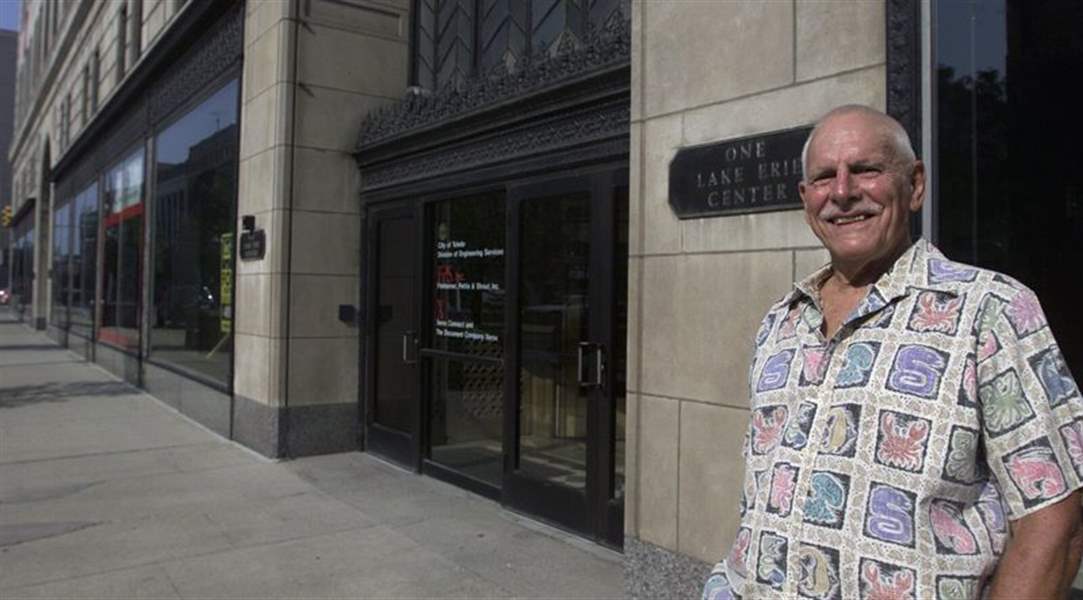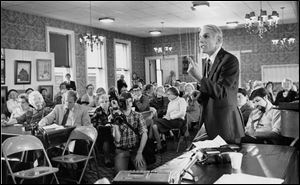
His heart is in downtown
8/24/2003
Lloyd Colenback, former owner of One Lake Erie Center, began his push for a revitalized downtown in the late 1970s. He now lives on Social Security and owes $1.5 million in taxes.
king / blade

Lloyd Colenback, former owner of One Lake Erie Center, began his push for a revitalized downtown in the late 1970s. He now lives on Social Security and owes $1.5 million in taxes.
On a scorching August morning six years ago, a tall, white-haired man emerged from the loading ramp door of an empty downtown Toledo building.
Cradling pictures he'd taken from his office wall, he folded his 6-foot frame into his Mercedes and made his way out of the city.
It was a quiet end for Mr. Downtown.
For 20 years, Lloyd Colenback had courted Toledo's central business district with a passion rivaled by few. He had dogged city leaders, badgered developers, and scolded city bureaucrats on downtown's behalf.
Finally, a new Owens Corning world headquarters had opened
But Mr. Colenback wasn't looking back.
“I was less than captivated by that time,” he said “I'd done everything in my capacity for downtown, but I was crushed financially.”
Indeed, the Michigan developer who in 1978 moved his money and heart to Toledo, these days lives in a small apartment just a few yards from the noise of passing Alexis Road traffic.
He drives a 1998 Oldsmobile with more than 115,000 miles on it and lives on Social Security.
He owes about $1.5 million in taxes.
Carty Finkbeiner, mayor from 1994 to 2001, was perhaps Mr. Colenback's only equal when it came to a passion for downtown measured in both sweat and decibels.
“It breaks your heart when you think about how much he carried the ball, maybe with one or two others,” Mr. Finkbeiner said. “There haven't been too many individuals who have had the real belief in downtown that Lloyd had.”
Bob Seyfang, a retired architect, consulted with Mr. Colenback a number of times before purchasing the downtown Bakery Building and moving there.
He wasn't alone.
“If you had a problem, Lloyd was the guy to turn to,” Mr. Seyfang said, “and I'm not sure how many people helped Lloyd when he needed it.”
It was the late 1970s when the former steel salesman strode into Toledo with a vision and a startling baritone.
It had been a period of “general malaise,” remembered Mike Young, then a city planner.
“Things were settled and quiet, and here comes this tornado,” Mr. Young said. “Lloyd challenged us. He forced us to be innovative, he forced us to explain ourselves.”
At meetings and hearings, Mr. Colenback questioned the wisdom of the Portside Festival Marketplace long before it failed and espoused the renovation of the Commodore Perry Hotel long before it happened.
He pushed for the reuse of the Edison steam plant long before plans were put into place, and urged planners to look eastward long before The Docks restaurants became a reality.
“Lloyd was probably one of the first people I remember hearing say we should look at the river running through downtown, rather than just being the edge of it,” Mr. Seyfang recalled.
An oratory gift wasn't surprising for the oldest of three sons born in 1928 to a Toledo Scale salesman and a suffragette.
“My mother was a staunch conservative,” he remembered. “She marched [for the right] to vote, and one of my first memories is going with her to vote for Herbert Hoover.”
In 1944, his parents moved to Vermont after his father was fired from his job here for drunkenness, he said. The teenager made his home there, choosing to stay for his senior year in high school when his parents returned a few years later to the Toledo area.
He threw himself into sports, and went to Colgate University in Hamilton, N.Y. He obtained a law degree from what is now Case Western Reserve University in Cleveland, working jobs as a butler and babysitter, bartender, and librarian to pay tuition.
Drafted at the end of the Korean War, he said he spent a year in the U.S. Counter Intelligence Corps “in a super secret little office in the bowels of the Pentagon ... following people around and going through their waste baskets for secret papers and - God forbid - top secret papers. It was a classic waste of taxpayers' dollars.”
It may have been the restlessness of a young man, or perhaps it was his father's suicide in 1950 that drove him from job to job.
“When my father returned [to the Toledo area], he stopped drinking and he worked all the time - 14 hours a day, seven days a week,” Mr. Colenback said. “I never talked to him about it, but I'm guessing he was terrified that if he stopped working, he'd start drinking.
“My mother,” he added simply, “found him at the end of a rope in our basement one day.”
In the years to come, the younger Colenback found no interest in military, the law, or even a stint as a steel salesman in Michigan. But something did fascinate him: the exodus of Detroiters out of downtown.
Despite little experience in development, he snapped up a couple of properties and built some of the first office and retail space along the bustling “golden corridor” of Big Beaver Road in Troy, Mich.
Among Mr. Colenback's tenants were employees of the Toledo-based Owens-Corning Fiberglas, as it was known then. Word was they wanted to move computer operations nearer to headquarters, then in Toledo's Fiberglas Tower.
Mr. Colenback reacted. He moved with his wife, Virginia, and his three children to Toledo. With a $4.5 million loan in 1978 he bought, renovated, and renamed as “One Lake Erie Center” the former Lamson department store at Toledo's Jefferson Avenue and Huron Street
Owens-Corning Fiberglas moved just as buildings sprang up along the Maumee stretching northward, anchored by a polished new Owens-Illinois headquarters in One SeaGate. In 1980, Mr. Colenback used his own money to buy a half-page ad in The Blade featuring a drawing of his vision of a downtown sports arena.
It appeared that the Glass City's downtown would sparkle again.
The hope was short-lived.
Urban flight and corporate downsizing of the 1980s thumped Toledo's downtown. The collapse of Toledo Trust, which had financed much of downtown's new construction, killed any remaining interest there.

Lloyd Colenback voices concerns at a local church in November, 1982, about the Portside Festival Marketplace. Later, in the 1990s, Mr. Colenback matched his enthusiasm with another strong supporter of downtown, Mayor Carty Finkbeiner.
The quieter downtown grew, the louder Mr. Colenback became.
“He was like a lone ranger out there,” Mr. Finkbeiner recalled. “Others might have been timid, following the Toledo Trust, but Lloyd was out there, plugging away.”
“He aggravated people just by being candid,” said Don Monroe, executive director of the River East Economic Revitalization Corp. “Some people want to be lied to if that's what makes them feel good.”
“Lloyd got things done by being a pain in the rear,” agreed Mr. Seyfang.
By the early 1990s, Mr. Colenback was named volunteer director of ToledoVision, a group of citizens and planners that were to put a new downtown master plan into place.
Into this same scene arrived a new strong mayor, Mr. Finkbeiner.
A taskmaster in his own right, Mr. Finkbeiner shared with Mr. Colenback the same vision for downtown but at times disagreed on the road map to get there.
There were titanic clashes that one city staffer likened to a match between Godzilla and Rodan.
Said Mr. Finkbeiner: “At times, neither one of us is the smoothest in our presentation when someone has crossed us. But I have to say I looked the smoothest when Lloyd was around.”
There were other forces at work too.
O-C-F was threatening to leave, threatening both the financial stability of downtown and Mr. Colenback. He flew to Washington and lobbied local leaders to help tear down what was considered a monstrosity of a federal building on Summit Street along the Maumee. His thinking: the eyesore's tenants would make a perfect fit for his soon-to-be vacant One Lake Erie Center.
But the feds weren't listening.
And on a blindingly sunny summer day in 1994, OC officials - flanked by state and local and federal politicians - turned the first shovels of dirt at their new headquarters in the south end of downtown.
It was bittersweet for Mr. Colenback.
It was confirmation he'd soon lose his biggest tenant and main source of income, but it was the first large-scale injection of confidence in downtown in many years.
The Valentine Theatre would be refurbished. COSI Toledo moved into the shuttered Portside, and a smattering of condos, offices, and shops would open.
Mr. Colenback stepped down from his seat at ToledoVision, which these days is known as Downtown Toledo, Inc., and other boards.
One Lake Erie was seized from him for foreclosure in 1997. Though Mr. Colenback was “forgiven” his outstanding debt, he was taxed on it as if it were income.
Owing nearly $1.7 million in federal taxes and penalties by 2001, records show he was ordered to sell a condo and turn over the proceeds to the IRS. He still owes more than $1.3 million, he said. His city tax bill, meanwhile, has climbed to more than $180,000.
For a short time, Mr. Colenback moved to Florida, where - after 42 years of marriage - he and Virginia split.
Ironically, it was Finkbeiner, Pettis, Strout, where the mayor's father had been a senior partner, that eventually moved into One Lake Erie Center after it was purchased by another developer in 1999 for less than $1.3 million.
“Lloyd has enormous staying power,” Mr. Finkbeiner said. “He just needed to stay another one or two years.”
The vision for downtown that Mr. Colenback and others began talking about in the 1970s had been turned over to a new crew of the 1990s, armed with a new economy, a new, strong-mayor form of government, and more diplomatic tongues.
Two-way, pedestrian-friendly streets with angle parking have replaced one-way thoroughfares. Artistic paving blocks and colorful flower boxes have replaced gray cement. A wrecking ball felled the federal building in 2001.
And though vacant office and retail space is woefully abundant, a fresh riverfront, Fifth Third Field, and new restaurants have lured to downtown scores of residents who hadn't been there for years.
“There are a lot of negatives in downtown,” said Frank Butler, a downtown activist and manager of several Toledo area properties, “but when you walk and look around, you see a lot of things that are directly or indirectly attributed to Lloyd.”
At 74, Mr. Colenback's days of meetings and speeches have been replaced by more mundane routines: a three-mile walk each morning followed by a cup of coffee and an orange.
Still, there are some things - like that baritone voice that can fill a room - that haven't changed.
Standing outside One Lake Erie Center recently, he glanced across Huron Street at the row of empty storefronts across the street. Mr. Colenback sighed. It's not his fight anymore.
“I equate it to a good Broadway show,” he said. “It had a great run for 25 years, but the show closed. It happens.”